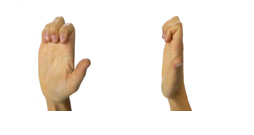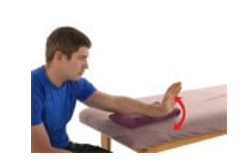- Reference Number: HEY-1397-2023
- Departments: Paediatrics, Physiotherapy
- Last Updated: 29 September 2023
Introduction
This leaflet has been produced to give you general information. Most of your questions should be answered by this leaflet. It is not intended to replace the discussion between you and the healthcare team, but may act as a starting point for discussion. If after reading it you have any concerns or require further explanation, please discuss this with a member of the healthcare team.
What is a Patient-Initiated Follow-Up (PIFU) pathway?
A patient-initiated follow-up (PIFU) means that we will not routinely book you an appointment, instead we are putting you in control of making your own appointments at a time when you need them most, within a given time frame.
How does PIFU work?
You will have been given this leaflet because your healthcare professional is happy that you do not need to see them again unless you have a problem. If you do have any problems, you can contact the Paediatric Therapy department on the given telephone number and they will arrange an appointment, either by telephone or face-to-face if it is needed. You will be told how long after your injury that you can contact the Paediatric Therapy department, on the PIFU pathway if you need to be seen.
When should I call for a PIFU?
You can call to make an appointment if you:
- are not improving to a level that was expected;
- have worsening symptoms relating to your injury/condition;
- have a “flare-up”.
Please note, you can only initiate a PIFU appointment for the specific injury/condition you were originally referred to the Paediatric Therapy service for.
When should I not use PIFU?
- If your concern is related to different injury/condition.
- If the specified time period has lapsed, please contact your GP.
- If you need urgent medical advice you should contact your GP or NHS111.
What if I don’t need a PIFU follow-up appointment?
You do not have to arrange an appointment if you feel it is not required. If you don’t contact us to book an appointment within the specified timeframe, the PIFU will expire and you will be discharged back to the care of your GP. We will not contact you to book a PIFU appointment – it must be initiated by you.
Booking a PIFU follow up appointment:
You or your parent/guardian can make an appointment to see us if you have any concerns related to your specific injury/condition. |
Should you require further advice on the issues contained in this leaflet, please do not hesitate to contact the Paediatric Therapy Department on telephone: 01482-674539.
What is a soft tissue injury?
The term soft tissue refers to muscles, ligaments and tendons that surround and support our joints. Injuries to the soft tissues can occur due to a fall, overuse, over stretching or direct impact and means there has been no injury to the bone.
Following a soft tissue injury you are likely to experience swelling, pain, bruising and tenderness and this can result in stiffness and loss of function. Soft tissue injuries can often feel worse in the first few days but it is important to move your wrist, hand and fingers immediately after the injury.
How should it be treated?
The most important initial treatment is aimed at controlling pain and swelling.
- Complete rest is not advisable but it is important to not over load or strain the injured area in the early stages of healing.
- Ice will help reduce pain and swelling. This can be ice cubes, crushed or frozen peas. It is important never to apply directly to the skin as this may cause ‘burning’. Wrap the ice in a damp towel and apply for a maximum of 10-15 minutes.
- Only use on areas that have normal skin sensation i.e. where you can feel hot and cold.
- Do not apply over an open wound
- Do not apply to an area of poor circulation, check your skin every 5 minutes and stop using if the area becomes white, blue or blotchy, excessively painful, numb or tingly.
- Simple pain relief can be bought over the counter and can help manage your pain, especially if taken regularly. If you have allergies or conditions which prevent the use of pain relieving or anti-inflammatory medication, please seek advice from your doctor or a pharmacist.
- If you have swelling in your wrist or hand, elevate your hand so that it is level or higher than your shoulder. The exercises below will also help to reduce the swelling especially if done in an elevated position.
Exercises
Complete rest is not advisable. It is important that you try to use your hand normally for light activities such as washing, dressing and eating and then gradually build back up to your normal levels of function. It is normal to feel mild discomfort at first, but this should gradually settle once the hand and wrist become stronger. If the discomfort continues after the exercises try reducing the number of exercises and build up again slowly.
The following exercises should each be repeated 10 times and completed every 2-3 hours. Support your elbow on the table with your wrist straight.
1. Finger/thumb extension
Straighten and stretch your fingers/thumb as straight/wide as you can. Hold for 10-20 seconds.

2. Hook
Bend your fingers/thumb at the small joints. Hold for 10-20 seconds.

3. Full fist
Bend your fingers and knuckles to make a fist as tightly as you can. Hold for 10-20 seconds.

4. Opposition
Take the tip of your thumb across to the tip of your little finger, then down the little finger. Hold the stretch for 10-20 seconds.

5. Wrist flexion/extension
Rest your forearm on a table with your hand over the edge. Using your wrist only, move your hand up to the ceiling. Feel the stretch and hold for 10 seconds. Repeat moving your hand down to the floor.

6. Wrist supination/pronation
Sit up straight in a chair with your elbow tucked in by your side with your elbow bent. Turn your palm up towards the ceiling as much as you can without moving the upper arm away from your body. Feel the stretch and hold for 10 seconds. Repeat turning your hand palm down.

All photos with kind permission of ©Physiotec™
Recovery
If you follow this basic advice your injury should take around 6 weeks to heal. However, everyone recovers from injuries at different rates and it is dependent on the severity of the injury and the presence of any other medical problems. It is possible that you may be back to normal in 2 weeks; however, it is also possible you may suffer symptoms for up to 3 months.
If you participate in an active hobby then it is advised that you do not return to this until you have full strength, full range of movement and can use your hand normally without experiencing pain or swelling.
If you play a sport involving the wrist and hand, practice the sports specific activities/movement and build these gradually before returning to full training sessions and competition.
When should I call for a Patient Initiated Follow Up (PIFU) appointment?
You should initiate a PIFU appointment if:
- you are struggling to fully straighten any of your fingers or thumb at 2 weeks following your injury or you feel it is getting worse;
- you are struggling to make a full fist or reach the base of your little finger with your thumb tip at 3 weeks following your injury;
- you feel your movement or function is worsening;
- your pain or swelling worsens.
Or after 6 weeks, you are struggling to return to your daily activities or hobbies.
If we do not hear from you 3 months following your injury date we will assume that you no longer require any further intervention and will be discharged from the PIFU pathway. If you have further problems with your finger after this date please contact your GP practice
Should you require further advice on the issues contained in this leaflet, please do not hesitate to contact the Paediatric Therapy Department on telephone: 01482 674539.
General Advice and Consent
Most of your questions should have been answered by this leaflet, but remember that this is only a starting point for discussion with the healthcare team.
Consent to treatment
Before any doctor, nurse or therapist examines or treats your child, they must seek your consent or permission. In order to make a decision, you need to have information from health professionals about the treatment or investigation which is being offered to your child. You should always ask them more questions if you do not understand or if you want more information.
The information you receive should be about your child’s condition, the alternatives available for your child, and whether it carries risks as well as the benefits. What is important is that your consent is genuine or valid. That means:
- you must be able to give your consent
- you must be given enough information to enable you to make a decision
- you must be acting under your own free will and not under the strong influence of another person
Information about your child
We collect and use your child’s information to provide your child with care and treatment. As part of your child’s care, information about your child will be shared between members of a healthcare team, some of whom you may not meet. Your child’s information may also be used to help train staff, to check the quality of our care, to manage and plan the health service, and to help with research. Wherever possible we use anonymous data.
We may pass on relevant information to other health organisations that provide your child with care. All information is treated as strictly confidential and is not given to anyone who does not need it. If you have any concerns please ask your child’s doctor, or the person caring for your child.
Under the General Data Protection Regulation and the Data Protection Act 2018 we are responsible for maintaining the confidentiality of any information we hold about your child. For further information visit the following page: Confidential Information about You.
If you need information about your child’s (or a child you care for) health and wellbeing and their care and treatment in a different format, such as large print, braille or audio, due to disability, impairment or sensory loss, please advise a member of staff and this can be arranged.

